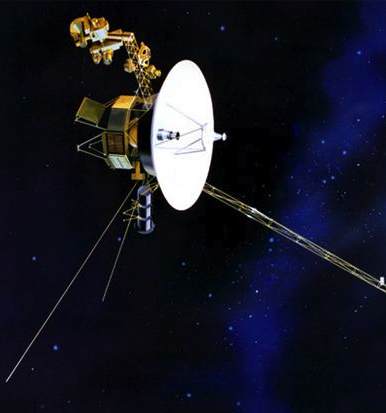 After being whipped around Jupiter and Saturn in a gravitational slingshot, the space probe launched by NASA in 1977 to study outside the Solar System has officially entered interstellar space. The US space agency announced this week that the 36-year-old probe, Voyager 1, is now about 12 billion miles (19 billion kilometers) from our sun traveling at 38,000 miles per hour.
After being whipped around Jupiter and Saturn in a gravitational slingshot, the space probe launched by NASA in 1977 to study outside the Solar System has officially entered interstellar space. The US space agency announced this week that the 36-year-old probe, Voyager 1, is now about 12 billion miles (19 billion kilometers) from our sun traveling at 38,000 miles per hour.
A gold-plated audio-visual disc onboard carries greetings recorded in 55 languages along with music by Mozart and Chuck Berry and images of Earth.
New and unexpected data indicate Voyager 1 has been traveling for about one year through plasma, or ionized gas, first detected on Aug. 25, 2012, which is present in the space between stars (interstellar space).
“Now that we have new, key data, we believe this is mankind’s historic leap into interstellar space,” said Ed Stone, Voyager project scientist based at the California Institute of Technology, Pasadena. “The Voyager team needed time to analyze those observations and make sense of them. But we can now answer the question we’ve all been asking — ‘Are we there yet?’ Yes, we are.”
In the event that the spacecraft is ever found by intelligent life-forms from other planetary systems, the gold disc features photos of the Earth’s flora, fauna and its people; a range of scientific information; spoken greetings from people such as the Secretary-General of the United Nations and the President of the United States and, “Sounds of Earth”, including the sounds of whales, a baby crying, waves breaking on a shore, and a collection of music including works by Mozart, Blind Willie Johnson, Chuck Berry’s “Johnny B. Goode”, Valya Balkanska and other Eastern and Western classics and ethnic performers.
“We expect the fields and particles science instruments on Voyager will continue to send back data through at least 2020. We can’t wait to see what the Voyager instruments show us next about deep space.”
Voyager mission controllers still talk to or receive data from Voyager 1 and Voyager 2 every day, though the emitted signals are currently very dim. Traveling at the speed of light, a signal from Voyager 1 takes about 17 hours to travel to Earth.
“Voyager has boldly gone where no probe has gone before, marking one of the most significant technological achievements in the annals of the history of science, and adding a new chapter in human scientific dreams and endeavors,” said John Grunsfeld, NASA’s associate administrator for science in Washington.
For a sound file of the oscillations detected by Voyager in interstellar space, animations and other information, visit: www.nasa.gov/voyager and www.jpl.nasa.gov/interstellarvoyager
(WATCH an interview with Neil deGrasse Tyson from this week)



















